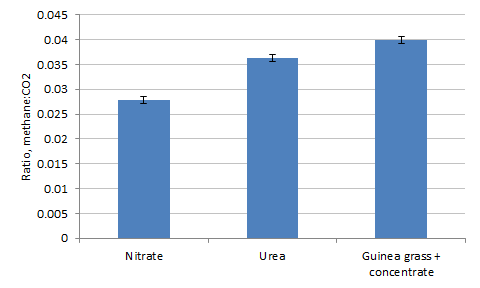 |
| Figure 1. Effect of calcium nitrate versus urea on ratio of methane to carbon dioxide in rumen gas from sheep |
|
Live stock production, climate change and resource depletion |
The hypotheses that were tested in this experiment were: calcium nitrate will support the same growth rate as urea when used as the source of rumen-fermentable N in diets based on NaOH-treated rice straw for growing sheep; methane concentrations in the rumen gas of sheep will be reduced when calcium nitrate is the N source compared with urea. The experiment was with 32 growing sheep of 17 kg initial live weight and continued for 84 days at the end of which the ratio of methane to carbon dioxide. in expired air was determined using a “GASMET” analyser. Feeding was NaOH-treated rice straw ad libitum and fresh cassava foliage at the rate of 1.5% of LW (DM basis). The treatments were: calcium nitrate or urea as the source of NPN. Sodium sulphate was added to both diets to give 0.4% of S in the diet. The urea/calcium nitrate was dissolved in water and sprinkled over the rice straw. The sodium sulphate was given in the same solution. The levels of the NPN sources were fixed at 1.2% N in the diet DM equivalent to 5.0% calcium nitrate and 2.6% urea.
Growth rates were similar on nitrate and urea but the ratio of methane to carbon dioxide in expired air was lower for the diets containing calcium nitrate (Figure 1). Samples of expired air from sheep fed guinea grass and concentrate had higher ratios of methane to carbon dioxide than sheep fed treated rice straw and urea.
 |
| Figure 1. Effect of calcium nitrate versus urea on ratio of methane to carbon dioxide in rumen gas from sheep |